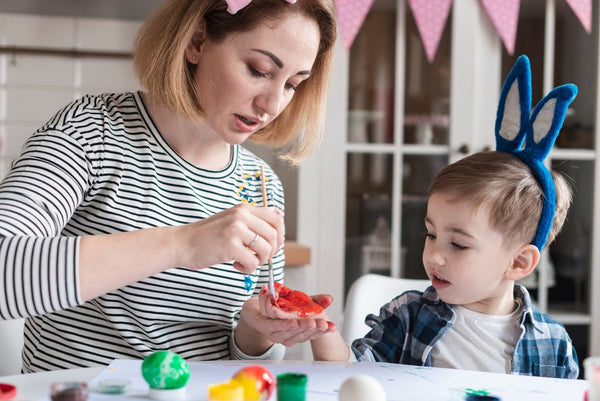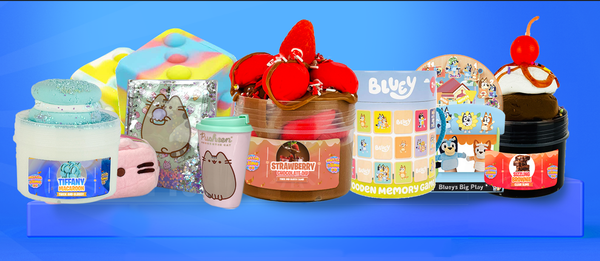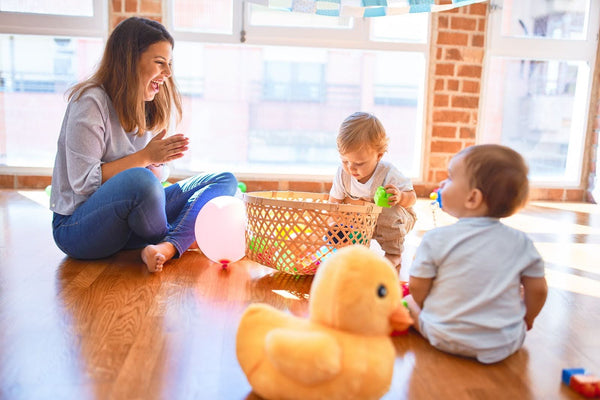
The Role of Sensory Toys in Speech and Language Development
For curious little minds, the world is a treasure trove of sights, sounds, smells, textures, and tastes. Sensory play, which allows children to explore these experiences through play, is a fundamental part of healthy development.
But did you know that sensory toys also benefit in speech and language development?
A study published in the peer-reviewed journal "Frontiers in Psychology" found that children engaged in sensory play activities showed improvements in their ability to use verbs and descriptive language. The study involved 64 toddlers, and those in the sensory play group scored higher on assessments measuring verb use and descriptive language skills compared to the control group.
This study highlights the potential of sensory play to enhance specific aspects of language development, like using action words and describing objects with more detail.*
Benefits of Sensory Play for Speech and Language Development
Let’s explore the fascinating connection between sensory stimulation and communication skills. We'll also discover how these seemingly simple toys can unlock a world of language learning for your child.
How Sensory Play Activities Encourage Speech and Language Development?

Sensory play engages multiple senses simultaneously, stimulating neural pathways in the brain. This sensory integration strengthens the foundation for various developmental areas, including speech and language.
Here’s how sensory play helps with speech development:
1. Vocabulary Expansion
Exposure to diverse sensory stimuli through toys introduces children to new words and concepts, enriching their vocabulary repertoire.
2. Improved Articulation
Manipulating sensory toys encourages fine motor skills and strengthens oral muscles, aiding in clearer articulation and speech production.
3. Increased Engagement
Interactive sensory toys captivate children's attention, fostering sustained engagement that facilitates language learning and communication.
4. Fine and Gross Motor Skills
Many sensory play activities involve grasping, manipulation, and movement, strengthening fine and gross motor skills that are essential for speech production.
5. Focus and Attention
Sensory activities for toddlers with speech delay can help focus their attention and block out distractions, fostering speech and language development.
Types of Sensory Toys for Speech and Language Development

The world of sensory toys is vast and exciting! Here are some popular options that can boost your child's speech and language development:
1. Textured Toys
Toys with varied textures, such as squishy balls or textured blocks, provide tactile stimulation that promotes sensory exploration and language development.
2. Auditory Toys
Musical instruments, sound puzzles, and talking toys engage auditory senses, facilitating auditory processing skills essential for language comprehension.
3. Visual Stimulation Toys
Brightly coloured toys, visual puzzles, and flashcards stimulate visual perception, supporting early literacy skills and language development.
4. Multi-sensory Toys
Toys that engage multiple senses simultaneously, such as sensory bins filled with different materials or sensory play kits, offer comprehensive sensory experiences conducive to language learning.
Remember...
The best sensory toys for speech therapy are those that are safe, age-appropriate, and capture your child's interest.
Best Sensory Toys for Language Development

Aussie Slime Co. offers a variety of sensory toys that can be incorporated into speech and language development activities:
A. Slime
The tactile nature of slime promotes hand-eye coordination and fine motor skills, while its squishy texture offers sensory input conducive to speech development activities.
B. Fidget Toys
Fidget spinners, stress balls, and sensory rings provide calming sensory input, helping children regulate their emotions and focus during speech development sessions.
C. Pop its Fidget Toys
Pop It toys offer satisfying tactile and auditory stimulation, engaging sensory modalities that complement speech therapy exercises aimed at articulation and phonological awareness.
D. Squishes and Plushies
Squishy stress balls and soft plushies like our boba tea plushie can be comforting and encouraging for speech and language development as they describe how the objects feel and create stories about their stuffed friends.
Speech Development Activities for Toddlers and Babies

Take sensory play a step further with these targeted activities to boost children’s speech development:
Sing Songs and Rhymes
Incorporate songs and rhymes that involve actions and sounds. Encourage your child to participate by making the sounds or completing the actions.
Play Pretend
Pretend play is a fantastic way for toddlers to practice new vocabulary and communication skills. Act out scenarios, narrate your actions, and encourage your child to do the same.
Storytelling with Props
Use sensory toys like textured animals or figurines to create stories. This helps them build vocabulary and practice sentence structure.
At-Home Sensory Play Ideas for Language Development
Here are some additional sensory play ideas you can try at home
Sensory Bins
Fill a container with various textures like sand, water beads, or shaving cream. Hide small objects like toys or pictures and encourage your child to find them, using descriptive language to describe the process.
Playdough Creations
Use play dough to create different shapes and objects. Talk about the process, the shapes you're making, and the colours you're using.
Nature Walks
Explore the outdoors and collect leaves, pinecones, or smooth stones. Discuss the textures, shapes, and colours, and create stories about your finds.
And That’s All!
Remember, sensory toys are not just a way to keep children entertained; they are valuable tools for promoting speech and language development. By providing rich sensory experiences and engaging in interactive play, you can help your child build a strong foundation for communication skills that will benefit them throughout their lives.
Explore: Doctor Squish DIY Magic Slime Set | Slime Subscription Box | Benefits of Sensory Toys for Children | How to choose the right sensory toy for your child | Slime recipes
